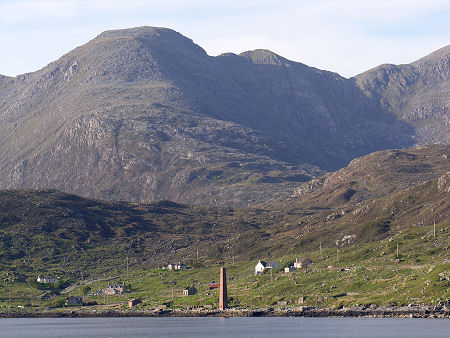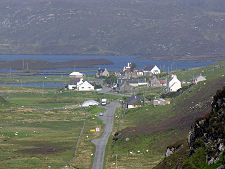 Old Whaling Staton at Bunabhainneadar & the North Harris Mountains |
William Lever, 1st Viscount Leverhulme, lived from 19 September 1851 to 7 May 1925. More usually referred to as Lord Leverhulme, he was an English industrialist, philanthropist and colonialist who, amongst many other ventures, for a time owned the whole of Lewis and Harris and had a profound and lasting influence on the island.
William Lever was born in Bolton, Lancashire in 1851, and educated at the Bolton Church Institute. His working life started in his father's wholesale grocery business. In 1886, Lever established a soap manufacturing company called Lever Brothers (now part of Unilever) with his brother James. It was one of the first companies to manufacture soap from vegetable oils, and proved enormously successful.
From 1888, Lever began to put his philanthropic principles into practice through the construction of Port Sunlight on Merseyside, a model community designed to house and support the workers of Lever Brothers, who already enjoyed generous wages and innovative benefits. Lever's philanthropy tended to be on his own terms. Life in Port Sunlight included intrusive rules and involved compulsory participation in activities. And with accommodation tied to employment, a worker losing his or her job could be almost simultaneously evicted. Despite all this, conditions, pay, hours, and benefits were all more favourable than normal for industry of the day.
In the early 1900s, Lever was using as a raw material palm oil produced in the British West African colonies. The need to expand capacity led him to visit the Belgian Congo in 1911, where he entered into a concession to obtain palm oil: an episode that casts a shadow over his reputation as many of the plantations from which Lever sourced his oil used a system of forced labour little better than slavery.
In 1918, Lord Leverhulme purchased the Isle of Lewis for £150,000 from the Matheson family: the northern two-thirds of the land mass that also includes Harris. He arrived to set up home in Lews Castle, Stornoway, with the declared intention of revolutionising the island and the lives of its 30,000 residents. Elements of his dream amounted to little less than an image of Port Sunlight reborn in an island environment, whose economy would be driven by the exploitation of the vast fish reserves in the surrounding seas. New fishing fleets would catch fish spotted by land-based aircraft; new ports would be built linked by railways and new roads to Stornoway, which would be transformed into a huge fish-processing centre. The output would be marketed through a 400 strong chain of retail fish shops, MacFisheries, set up across the length and breadth of the United Kingdom. Meanwhile a chemical industry would be developed processing the seaweed so plentiful around the island; peat would be used in large scale power stations; and unproductive land transformed into forests or fruit and dairy farms. Lewis would grow to become an island of up to 200,000 people. He set to work with considerable energy, and over the following years would invest the better part of a million pounds on Lewis.
There were two main problems with Lord Leverhulme's grand scheme. The first was that the state of the fish market in the UK was probably never sufficiently strong to drive that critically important element of it forward. The second was that many of the islanders of Lewis had a very different view of their future. For many decades there has been growing dissatisfaction over the fact that insufficient land was available for crofting. In the aftermath of the First World War, in which a disproportionate 1000 of those who enlisted from the island had been killed, and 205 more drowned when the troopship Iolaire sank in the entrance to Stornoway harbour on 1 January 1919 (the reason why many Hebridean war memorials refer to the war of 1914-1919), the pressure for land reform grew to bursting point.
Leverhulme was not a man to whom compromise came naturally, and neither was he known for his patience. Still worse, he saw the expansion of a crofting economy as running directly in conflict with his own dreams. Matters came to a head when he did not receive the popular support he expected at public meetings, and "land raiders" settled on areas of his farmland near Stornoway in an effort to force the creation of more crofts. The Scottish Office, which tried to steer a middle course declined to give Leverhulme all the support he thought he was due. His response was unexpected: he brought the whole of Harris in two lots in May and June of 1919, paying £20,000 for South Harris and £36,000 for North Harris.
In the face of more occupations of his land in Lewis, Leverhulme announced in February 1920 that he was ceasing development work in Lewis, and would in future focus wholly on Harris. The centre of his attention was the small fishing port of Obbe, which (following some heavy hints from their new owner) the residents decided should be called Leverburgh. Two years later he revived the whaling station at Bunabhainneadar.
Meanwhile, Lord Leverhulme's attention and resources were focused elsewhere. A poor business deal in Nigeria in 1920 almost took him and his company into liquidation and for a while his ability to invest in Harris dried up. By 1922 the situation in Lewis had become intractable, and many of those who wanted crofting land chose to emigrate instead. In September 1923, Leverhulme admitted defeat and made the truly remarkable offer to give Lewis in its entirety to its residents. His proposal was to divide it into two areas: the land within 7 miles of Stornoway and the rest, and give each part to a separate trust to be set up for the benefit of the residents. It rapidly became clear that the Stornoway element could be self sustaining; but that the second proposed trust looking after the remainder of Lewis could not. The Scottish Secretary, Viscount Novar, in an act of monumental short-sightedness, refused to cover the funding gap of £1,365 per year needed to allow the second trust to operate. The land offered as a gift to it - most of Lewis - was instead put on the market, though it proved very difficult to sell at any price.
Lord Leverhume died of pneumonia after a trip to Africa in May 1925. His son immediately pulled the plug on all investment in Harris. £250,000 had been spent on new works and facilities in Leverburgh, but Leverhume's dream died with him, and the plant at Leverburgh was sold for just £5,000 to a demolition company. The vast South Harris estate, purchased in 1919 for £36,000, was sold for just £900. Other parts of Lewis and Harris were sold piecemeal with the exception of the area under the control of the Stornoway Trust.


